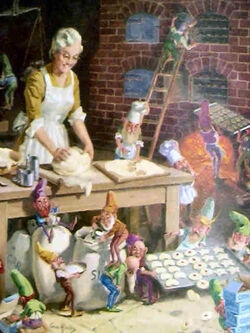| Mrs. Claus | |
|---|---|
 | |
|
Real Name |
Kristina Kringle / Mary Christmas / Bessie |
|
First Appearance |
(Historically believed to be) Mysteries of City Life (1848) |
|
Created by |
James Rees |
Origin
The wife of Santa Claus, she is believed to have been introduced in the short story "A Christmas Legend" (1849) by James Rees (however, realistically, someone, somewhere most likely told their child that Santa had a wife long before that). The idea found its way in several short stories over the following decades until becoming the protagonist of "Goody Santa Claus on a Sleigh Ride" (1888) by Katharine Lee Bates (Goody being short for "Goodwife" used instead of Mrs.). In Bates' poem, Mrs. Claus wheedles a Christmas Eve sleigh-ride from a reluctant Santa in recompense for tending their toy and bonbon laden Christmas trees, their Thanksgiving turkeys, and their "rainbow chickens" that lay Easter eggs. Once away, Mrs. Claus steadies the reindeer while Santa goes about his work descending chimneys to deliver gifts. She begs Santa to permit her to descend a chimney. Santa grudgingly grants her request and she descends a chimney to mend a poor child's tattered stocking and to fill it with gifts. Once the task is completed, the Clauses return to their Arctic home. At the end of the poem, Mrs. Claus remarks that she is the "gladdest of the glad" because she has had her "own sweet will".
She has since appeared in multiple literature stories, comic books and (less often) in film and television.
In “There Was a Boy Who Lived on Pudding Lane,” Santa Claus grows up in Cole’s kingdom alongside nursery rhyme characters and marries a local woman named Bessie before moving with her to the North Country to become toymakers for the children of the world.
In some stories, she and Santa have offspring: Kitty Claus, or Bertha and Fritz.
Public Domain Literary Appearances
- “A Christmas Legend,” in Mysteries of City Life; or, Stray Leaves from the World’s Book, Being a Series of Tales, Sketches, Incidents, and Scenes, Founded upon the Notes of a Home Missionary, by James Rees, 1848. (HathiTrust)
- “Mrs. Santa Claus and Jessie Brown,” Harper’s Weekly: A Journal of Civilization, vol. 13, no. 628, 9 Jan. 1869. (Internet Archive)
- “Goody Santa Claus on a Sleigh‐Ride,” by Katharine Lee Bates, Wide Awake, vol. 28, no. 1, Dec. 1888. (HathiTrust)
- Reprinted in Sunshine and Other Verses for Children, 1890. (Internet Archive)
- Santa Claus’ Daughter: A Musical Christmas Burlesque in Two Acts …, by Everett Elliott and F. W. Hardcastle, Ames’ Series of Standard and Modern Drama, no. 309, 1892. Santa Claus is portrayed as a king, “Ruler of the Kingdom of the North Pole,” where he lives with Mrs. Santa Claus and their daughter in a “Snow Castle” or “Snow‐palace.” (Mrs. Santa Claus should logically be the queen but she is not described as such.) The kingdom is defended by, among others, a female personification of Christmas, a separate character from Mrs. Claus/Mother Christmas. (Internet Archive)
- “The Conquest of Santa Claus: A Christmas Entertainment,” by Caroline A. Creevey and Margaret E. Sangster, Harper’s Young People, vol. 16, no. 787, 27 Nov. 1894. (Internet Archive)
- “A Child’s Christmas Prayer” (poem), in Songs with Silver Linings, by James W. Foley, 1910. (HathiTrust)
- Mrs. Santa Claus, Militant: A Christmas Comedy, by Bell Elliott Palmer, 1914. Mrs. Santa Claus gets tired of making toys in Iceland while Mr. Santa Claus (whom she calls “Jolly”) gets all the credit, so she waits for him to take a nap and then steals his sleigh and attempts to deliver the Christmas presents herself, mixing some of them up due to her inexperience. The final gifts are delivered to a squalid New York City tenement where Mr. Santa Claus catches up to her and declares that she shall ride with him every Christmas thereafter. (Google Books)
- When Santa Claus Went to the Front, by Ethel E. Reed and Martha G. Kendall, 1918. (Internet Archive)
- Telephoning to Santa Claus, by John D. MacDonald, 1919. (Internet Archive)
- A Christmas Dilemma, by Katharine Van Etten Lyford, 1920. (Internet Archive)
- “There Was a Boy Who Lived on Pudding Lane: A True Account, if Only You Believe It, of the Life and Ways of Santa, Eldest Son of Mr. and Mrs. Claus,” by Sarah Addington, The Ladies’ Home Journal, vol. 38, no. 12, Dec. 1921. (HathiTrust)
- Queen Christmas: A Pageant Play, by Carolyn Wells, 1922. (Internet Archive)
- “The Great Adventure of Mrs. Santa Claus,” by Sarah Addington, The Ladies’ Home Journal, vol. 39, no. 12, Dec. 1922. (HathiTrust)
- The Christmas Forest, by Louise Fatio, 1950. In the public domain from failure to renew copyright. (HathiTrust)
See Also
- Spring the Beauty (said in at least one tale to have a daughter with Ded Moroz/Santa Claus)
- Comic Vine
- Wikipedia
- Santa & Mrs. Claus being issued Canadian passports!
- Christmas Specials Wikia